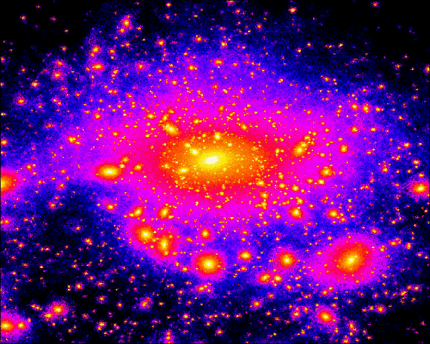Puffy Milky Way
Milky Way to survive collision
 © Stelios Kazantzidis, Ohio State University |
This image from a supercomputer simulation shows the density of dark matter in our Milky Way galaxy which is known to contain an ancient thin disk of stars. Brightness (blue-to-violet-to-red-to-yellow) corresponds to increasing concentration of dark matter.
- » 1 - Mysterious web of dark matter
- » 2 - Is our current model of the universe correct?
Mysterious web of dark matter
The finding solves two mysteries: the likely fate of the Milky Way at the hands of its satellite galaxies -- the most massive of which are the Large and Small Magellanic Clouds -- and the origin of its puffy edges, which astronomers have seen elsewhere in the universe and dubbed “flares.”
The mysterious dark matter that makes up most of the universe plays an important role.
Astronomers believe that all galaxies are embedded within massive and extended halos of dark matter, and that most large galaxies lie at the intersections of filaments of dark matter, which form a kind of gigantic web in our universe. Smaller satellite galaxies flow along strands of the web, and get pulled into orbit around large galaxies such as our Milky Way.
Ohio State University astronomer Stelios Kazantzidis and his colleagues performed detailed computer simulations of galaxy formation to determine what would happen if a satellite galaxy -- such as the Large Magellanic Cloud and its associated dark matter -- collided with a spiral galaxy such as our own.
Their conclusion: The satellite galaxy would gradually disintegrate, while its gravity tugged at the larger galaxy’s edge, drawing out stars and other material. The result would be a flared galactic disk such as that of the Milky Way, which starts out narrow at the center and then widens toward the edges.
The results may ease the mind of anyone who feared that our galactic neighbors and their associated dark matter would eventually destroy our galactic disk - albeit billions of years from now.
Kazantzidis couldn’t offer a 100-percent guarantee, however.
“We can’t know for sure what’s going to happen to the Milky Way, but we can say that our findings apply to a broad class of galaxies similar to our own,” Kazantzidis said. “Our simulations showed that the satellite galaxy impacts don't destroy spiral galaxies -- they actually drive their evolution, by producing this flared shape and creating stellar rings -- spectacular rings of stars that we’ve seen in many spiral galaxies in the universe.”
Puffy Milky Way
Milky Way to survive collision
 © Stelios Kazantzidis, Ohio State University |
This image from a supercomputer simulation shows the density of dark matter in our Milky Way galaxy which is known to contain an ancient thin disk of stars. Brightness (blue-to-violet-to-red-to-yellow) corresponds to increasing concentration of dark matter.
- » 1 - Mysterious web of dark matter
- » 2 - Is our current model of the universe correct?
Mysterious web of dark matter
The finding solves two mysteries: the likely fate of the Milky Way at the hands of its satellite galaxies -- the most massive of which are the Large and Small Magellanic Clouds -- and the origin of its puffy edges, which astronomers have seen elsewhere in the universe and dubbed “flares.”
The mysterious dark matter that makes up most of the universe plays an important role.
Astronomers believe that all galaxies are embedded within massive and extended halos of dark matter, and that most large galaxies lie at the intersections of filaments of dark matter, which form a kind of gigantic web in our universe. Smaller satellite galaxies flow along strands of the web, and get pulled into orbit around large galaxies such as our Milky Way.
Ohio State University astronomer Stelios Kazantzidis and his colleagues performed detailed computer simulations of galaxy formation to determine what would happen if a satellite galaxy -- such as the Large Magellanic Cloud and its associated dark matter -- collided with a spiral galaxy such as our own.
Their conclusion: The satellite galaxy would gradually disintegrate, while its gravity tugged at the larger galaxy’s edge, drawing out stars and other material. The result would be a flared galactic disk such as that of the Milky Way, which starts out narrow at the center and then widens toward the edges.
The results may ease the mind of anyone who feared that our galactic neighbors and their associated dark matter would eventually destroy our galactic disk - albeit billions of years from now.
Kazantzidis couldn’t offer a 100-percent guarantee, however.
“We can’t know for sure what’s going to happen to the Milky Way, but we can say that our findings apply to a broad class of galaxies similar to our own,” Kazantzidis said. “Our simulations showed that the satellite galaxy impacts don't destroy spiral galaxies -- they actually drive their evolution, by producing this flared shape and creating stellar rings -- spectacular rings of stars that we’ve seen in many spiral galaxies in the universe.”





